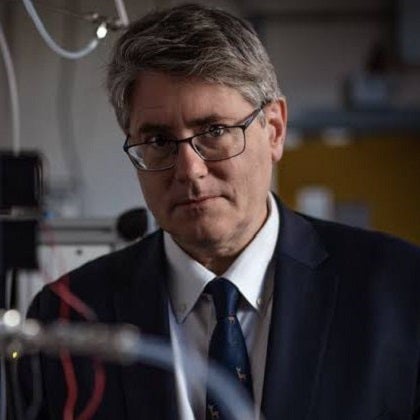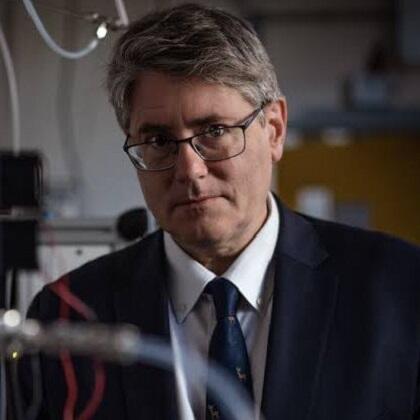Microplastics, Public Health Myth or Menace
Share
- Details
- Text
- Audio
- Downloads
- Extra Reading
Microplastics - tiny plastic particles less than 5mm long - were first identified in the ocean but are now known to be ubiquitous throughout the environment, within soil, air food and water. Recently, microplastics have been detected in human blood, placenta, and other tissues (liver, lung, colon) raising concerns about potential adverse health effects.
This lecture reviews the science on microplastics and whether we should be concerned about them, compared with other known environmental hazards.
Download Text
Microplastics, Public Health – Myth or Menace
Professor Ian Mudway
25th September 2023
Humans have evolved to live within a complex and changing chemical environment, but the rate of synthesis of new chemical entities and novel materials has increased dramatically over the last century, presenting new and often unforeseen challenges to the environment and public health.
In this series of three lectures, we will explore two topics of increasing public concern: microplastics and the so call forever chemicals (Per- and polyfluoroalkyl substances), before reflecting on the lessons learned from the regulation of lead emissions. The removal of lead from petrol is a major public health success story but lead persists within our environment and their remain impacts on human health.
These lectures are about reviewing what we know, fact checking what appears in a media, fond of the next major scare story, and thinking wholistically about how we ensure environmental protection and health are considered across the full life cycle of chemical manufacturer, use and disposal. These lectures are all linked; the microplastic story is inextricably linked to both PFAS (Perfluoroalkyl-and polyfluoroalkyl substances) and lead, building upon the lectures from my previous series focusing on the exposome, air pollution and the nature of our mucosal barriers with the outside world.
Science, like everything else is subject to fashions and fads, albeit ours are a little more evidence based, and at present in the world of environmental health, the topic of microplastics is ‘hot.’ Not a week goes by without some new story emerging in the popular press concerning the ecological impacts of microplastic pollution in our oceans and rivers, or evidence of plastics accumulating in the human body. From a scientific perspective, there is often a lack of precision in the language used, and a tendency to dogmatically refer to risks, which are quite frankly not well quantified, or understood. There are very significant gaps in our understanding of both the extent of environmental microplastic pollution, and its likely impact on the ecosystem, including human health. There are emerging hints and inferences that have been presented as hard facts, and so in this lecture I think it’s time to recalibrate a little.
Let’s at least begin, by acknowledging that we have a problem. A very significant waste problem, of which plastics is just a part. Plastics are ubiquitous in our daily lives, and since mass production really took off after the end of the WW2 we have produced somewhere in the order of 8.3 billion tons, of which, despite the focus on accumulation within the oceans, most (approximately 80%) has gone into landfill. This is an expanding problem with global plastic production predicted to reach 33 billion tons by 2050. Once in the environment the very properties that make plastics desirable materials: their strength, durability, and resistance to corrosion, contribute to their persistence, slowly breaking down into smaller and smaller fragments.
The focus on oceanic plastic accumulation reflects the fact that the earliest studies in the field were conducted by Richard Thompson’s group at The University of Plymouth. In their seminal paper published in Science in 2004, they examined sediments from beaches and estuaries around Plymouth and were able to identify a range of plastic fragments (predominately fibres of approximately 20 mm diameter) using Fourier Transform infrared spectroscopy, demonstrating the presence of nine polymers: acrylic, alkyd, poly (ethylene:propylene), nylon, polyester, polyethylene, polymethylacrylate, polypropylene and polyvinyl alcohol. They were also able to demonstrate that the abundance of these plastics fragments had increased over time using archived plankton samples collected between the 1960s to 1990s. When plastic particles/fibres were presented experimentally to deposit and filters feeders (amphipods, barnacles, and lung worms), they were consumed raising the possibility of their accumulation within the food chain. This initial set of findings was followed by numerous studies confirming this observation and demonstrating the accumulation of microscopic plastic particles and fibres in a range of species, from filter feeders to higher vertebrates. These studies in addition to confirming that plastic waste was reaching and accumulating in the oceans, demonstrated that uptake in aquatic animals was associated with clear signs of toxicity, with impacts on growth, reproduction, and life span.
As the field evolved in developed its own terminology. Microplastics were defined as any solid synthetic polymeric fibre, or particle of no more than 5mm in their longest dimension. So not micro, in conventional usage, and nano plastics were defined similarly, though as being no more than 1mm, again, not really nano- in the way in which nanoparticles had formerly been defined. Microplastics could also be defined as being primary, or secondary, the former being manufactured as submicron beads for various cosmetic or industrial purposes. In contrast secondary microparticles were the products of the breakdown of larger plastic items through various environmental processes, including biodegradation, photodegradation, thermo-oxidative degradation, thermal degradation, and hydrolysis. The relative abundance of microplastics within the environment reflected their use in consumer products, polyethylene, polypropylene, polystyrene, polyamide, polyester and acrylic, but there was added complexity due to the additives employed in their manufacture (Bisphenol A, phthalates, brominated flame retardants etc), and their potential to accumulate/absorb other environmental toxins and toxicants onto their surface.
Rapidly following the identification of microplastics in human foodstuffs concerns began to be raised about their potential impact on human health. There followed numerous papers quantifying microplastics in everything from supermarket purchased fish, to bottled water., even tea It also became apparent the microplastic particles and fibres were also present in air, providing another route for their uptake into the human body. The media ran with these stories, often without an adequate level of critique, or context, helping to shape a popular (mis)understanding of microplastic risks to health. It became accepted wisdom that microplastics pervaded all aspects of life at high concentrations, that they were entering the body through our diets and the air we breathe and seeding themselves within our organs, causing disease. This appeared to be taken as a given, with little appreciation of the significant challenges inherent in identifying microplastics, at the sizes likely to penetrate the respiratory and gut epithelium, without clear evidence of overt pathology associated with microplastic accumulation. Indeed, in the absence of evidence of meaningful accumulation, with little relevant toxicology and no robust health studies. This was not to say that this might have accumulated with time, but in was clear that the field was running ahead of itself. Even amongst the scientific community working in the area, statements began to proliferate, that emphasised the importance of the issue, but were probably not entirely true, or justified based on the evidence based. We were apparently eating a credit card of plastic a week. This is palpably not the case. It’s repeated ad nauseum and uncritically in the media, at science meetings despite having been systematically taken apart in subsequent articles. There is a real case to ne made, for being concerned about microplastics, which is not well served by hyperbole.
Currently analytical challenges mean it is difficult to quantify microplastics at the nano to micro-size range that are likely to be toxicologically relevant to human health. Larger particles are clearly present in the environment, and the inference is that the smaller particles are there, and we are just waiting for the technology to catch up. That does not seem an unrealistic proposition. Quantifying these particles/fibres within the tissue environment adds entirely new complexities. Currently tissues are digested and sieved, prior to applying solution-based chemistry to identify a molecular signature of a plastic polymer or polymer associated chemical, but this prevents correlation with pathology. Some ‘particle in situ’ work has been performed using Raman spectroscopy, but this is literally like hunting for a needle in a haystack, and perhaps this reflects the fact that microplastics are not the most abundant particles and fibres were encounter in out daily lives, and that clearance mechanisms in the lung and gut mostly do a good job at preventing the accumulation of these materials in the body. If we just focus on the inhalation route the proportion of microplastics in ambient PM2.5 will be low compared with other components. How low, we don’t know, because to date most of the information we have on airborne microplastics is derived from studies looking at deposition samples, or sampled total suspended particles, which capture larger particles and fibres, but probably not more than around 1% of the total number of particles identified.
That doesn’t mean they are of no-significance, because biological persistent particles and fibres of other types (asbestos, carbon nanotubes) are known to elicit adverse tissue responses, and indeed high occupational exposures to plastic fibres in the flocking industry has been associated with inflammation and fibrosis of the lung. Whether these responses occur at normal ambient level however is not known. However, by looking at commonalities with other insoluble materials like silica, it is possible to begin to construct a theoretical model of how microplastics could cause injury in vivo, and importantly this presents a framework for experimental evaluation. This approach is needed urgently in the microplastic field where there is a relative absence of comprehensive toxicological studies with realistic dose ranges and representative materials.
Whilst there are significant knowledge gaps regarding microplastic polymers, there is a richer toxicological literature regarding some of the additives used in plastic manufacture. This issue was recently addressed by United Nations Environment Programme, which identified the presence of 7,000 additives known to be hazardous and over 3,000 that were deemed to be of potential concern, including metal/metalloid (including Pb), flame retardants, bisphenols and PFASs. This raises issues regarding whether a preoccupation with particle and fibre retention in tissues has result in a neglect of the risks associated with these chemical leaching into the wider tissue environment. However, as always, the critical issue is the effective biological dose of these chemicals, in the lung, gut, blood and liver.
Tyre wear has also recently become a significant topic of conversation, thought there is an ongoing debate about whether it should be considered a ‘true microplastic’, or exists in a separate elastomer grouping. This is a very academic question. The microplastic community tend to view it as a highly significant environmental microplastic (certainly in terms of emissions – 7.4 and 8.5% of UK PM2.5 and PM10 respectively), whilst industry and researchers working on vehicle non-exhaust emissions are resistant to this classification. In part this reflects the fact that tyre wear is a composite of polymer (natural and synthetic), filler (carbon black), and metals, so that the ‘true microplastic’ contribution will be a fraction of the numbers given above. Nether-the-less there is an increasing push to understand exposures to these emissions, particularly as they will remain, and potentially become worst, as global vehicle fleets transition away from the combustion engine toward electrification. It is also possible, because of the knowledge of emissions from tire, allied to the presence of good tracers (Zn and 6PPD, a common rubber antiozonant), to begin to think about potentially modelling global exposures, which is currently not feasible for microplastics overall due to the absence of good comprehensive environmental measurements. This raises the possibility of beginning to perform indirect epidemiological evaluation of at least one form of microplastic if some consensus emerges around these definitions.
In conclusion, the aim of this lecture was to determine what is myth and what is fact around the topic of microplastics. I have been very critical of the current state of play, but that does not imply that I believe the topic isn’t of great global significance. From an ecological perspective it is more than clear that we need to prevent the accumulation of macro and microplastic debris in our oceans and freshwater bodies to preserve biodiversity. What is less clear is what the impact on human health will be and here there needs to be clear heads and careful language (the current microplastics terminology is unhelpful for integration into health studies), otherwise the field might do itself great harm before it has fully parametrised the challenge faced? Much more effort needs to be invested in quantification, both of microplastics in the environment, as well as within human tissues, and in the latter case this needs to extend to a more comprehensive evaluation of additive effects. Ultimately, as with many environmental health issues the solution requires a reduction in emissions (dare one say production), allied to new technologies either to allow recycling and reuse, or to ensure effective biodegradation within the environment. This will require a global effort, the waste issue is a challenge of this magnitude, because presently part of the solution for developed economies is to export their problem to emerging nations. This is not good global citizenship. Undoubtably, this will require innovation, but perhaps if the microplastics issue teaches us one thing it’s to be acutely alert to the risk of untoward consequences of the most obvious solutions. and to reflect on the value of the precautionary principle. History has a tendency to prove it right.
© Professor Mudway 2023
References and Further Reading
For an historical perspective of the development of the plastic industry:
https://www.scientificamerican.com/article/a-brief-history-of-plastic-world-conquest/
The World Health Organisation recently reviewed the link between microplastics and health:
https://www.who.int/publications/i/item/9789240054608
UPEP recently covered the potential hazard associated with additive within the plastic manufacturing process.
https://www.unep.org/resources/report/chemicals-plastics-technical-report
References and Further Reading
For an historical perspective of the development of the plastic industry:
https://www.scientificamerican.com/article/a-brief-history-of-plastic-world-conquest/
The World Health Organisation recently reviewed the link between microplastics and health:
https://www.who.int/publications/i/item/9789240054608
UPEP recently covered the potential hazard associated with additive within the plastic manufacturing process.
https://www.unep.org/resources/report/chemicals-plastics-technical-report
Part of:
This event was on Mon, 25 Sep 2023
Support Gresham
Gresham College has offered an outstanding education to the public free of charge for over 400 years. Today, Gresham College plays an important role in fostering a love of learning and a greater understanding of ourselves and the world around us. Your donation will help to widen our reach and to broaden our audience, allowing more people to benefit from a high-quality education from some of the brightest minds.


 Login
Login







